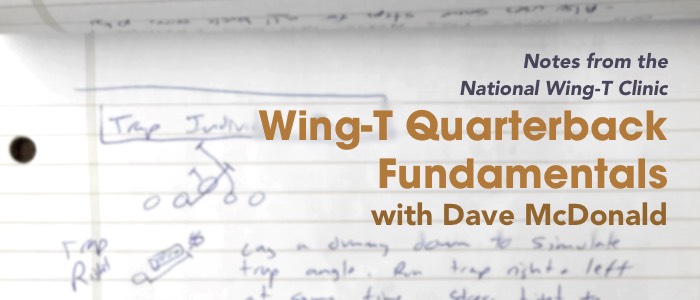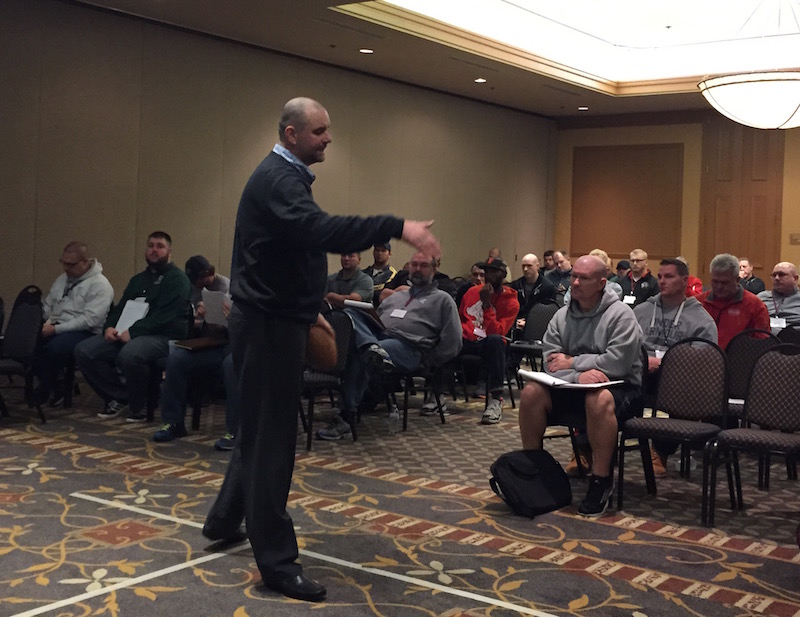Quarterback Fundamentals with Dave McDonald

Dave McDonald is the head football coach at Connellsville HS, southeast of Pittsburgh. Dave led a highly interactive overview of Wing-T quarterback fundamentals – it reminded me of of Gerry Gallagher’s Wing-T QB clinic DVD.
Introductory Comments
Dave had a few key talking points for Wing-T quarterbacks:
- Focus on precision: “8 inches means 8 inches”
- Be detail oriented and always be coaching up
- QBs must be committed to the fake, the run, and the throw
- QBs must go through reading/throwing progression on every play with a pass fake (boot, ISO/belly, down, etc.) and be prepared to tell coach what he is seeing. For example, if on boot his read progression is deep to flat to run, he should be able to communicate exactly what his read was each time he runs buck sweep or trap.

Stance and Pre-Snap Thought Process
- The quarterback should have a narrow base because it helps allow a big first step to get deep quickly. Wide base means less room to move on the pivot.
- Keep a slight knee bend while standing tall to help with visual scan of defense
- The QB should be only wrist deep under the center’s butt, again to allow QB to be as deep off LOS as possible.
- Before snap he should go through the following progression:
- Scan his own formation: is everyone aligned properly based on the call?
- What is the defensive front (even/odd) as this could lead to an audible check off
- What is the secondary coverage scheme? Dave teach “open roof or closed roof” (2 high safeties or 1 high)
Taking the Snap
- Center should keep the laces to the side of QB throwing arm
- QB and center should practice a slow exchange with just one hand, working on communication for the exchange. Do hand-back where QB places ball in spot he’d like to receive it, then center takes it back for repetition practice
- Again, key point: deep off the center – gotta make room for those pulling guards!
- After exchange is working with good tempo, move onto progression:
- Center then starts taking a first step. QB should call a play quickly before snap to reinforce center knowing the proper first step for that play
- Similarly, the QB practices bellying the ball, closing elbows, taking his first step
Midline work – Start with Buck Sweep Right
I’ve historically taught the QB and FB to use different midline relationships on the Buck series depending on the play. However, a key point I heard across multiple sessions: most coaches I talked to have moved away from alternate midline footwork based on the specific play within a series. For example, they have the QB execute exactly the same footwork for all plays in the Buck series. The result, in the case of Buck series, is that the QB is slightly off midline for all the plays, and the FB is partly over the midline for all the plays. This will make more sense when I talk through the footwork and bird dog approach they use.
QB steps (and bird dog counts) for Buck Sweep Right:
- First step on reverse pivot is 8 inches over the midline with his left foot, ball to the belly (3rd hand), as deep as the QB can go. So this looks like slightly more than a full 180 degree reverse pivot. As QB is working this, coach says “check your feet out”: are toes parallel to the midline? Is the left foot about 8 inches over the midline?
- Second step (with the right foot) is deep and just inside (across) the midline. Perform a chicken-wing proximity fake (younger kids can just click-click with shoulder pad proximity).
- Third step is a 45 degree step with the left foot back across the midline with the ball in the left hand. The ball should be almost exactly on the midline at this point as the quarterback hands off. When running bird dog the QB would just drop the ball here.
- On the fourth step the QB is continuing towards his flat to line-of-scrimmage (LOS) trajectory. The QB should put both hands up field (away from defense) like he is finding the laces, with eyes downfield working to find his first read progression.
- The QB will be completely flat to LOS by his 6th step.
- On the 8th step, if the QB is right handed, he would plant on his right foot and throw the out cut which is his first (deep) read.
- On the 10th step, again if the QB is right handed, he would plant and throw for the short throw to the FB.
Buck Trap
- Coach exactly the same footwork as for buck sweep. Same midline relationship.
- On the 2nd step, the ball comes out at forearm length to the fullback. The eyes of the QB go to the fullback on this step – it is the quarterback’s job to put the ball in the right place. The FB eyes should be downfield to find his hole and cut.
- On the 3rd step don’t use a hand fake, just focus on mesh with the wingback.
- Everything else is the same (boot fake)
Boot
- Same as buck sweep, but on the 3rd step the QB will place the ball “right off his left nut” (ahem).
- On boot right for a right-handed QB, probably want QB to throw deep route on his 7th step (right foot).
Jet Sweep Right
While some coaches have the QB swing wide open with his back into playside A gap, Dave has had success using basically the same footwork as buck sweep. Key points:
- Use a shorter first step instead of long - about 8–10“ deep, still 8” over midline.
- QB rides ball from his right thigh across to his left thigh as he gives handoff to the wingback
- He recommends trying “pinky pinky” for the jet handoff (WB hands pinky to pinky with palms up).
Jet Trap
This is for the fullback trap play off the jet sweep fake. This looks a lot like the Buck trap play, but the sweep fake comes before the fullback handoff instead of after.
They snap a bit later to give WB time to clear and return to full depth footwork like buck sweep (meaning, the quarterback will take full first pivot step with depth). In this regard the footwork is identical to buck trap except there’s no halfback fake afterwards.
Rocket Sweep Right
- QB can pigeon toe a bit to make it easy to make the wide swing for rocket toss. The ball should pass from right hip to left hip, just like bailing water out of a boat. Don’t let hands get too high: they shouldn’t come above the numbers.
- QB has a natural second step with his right foot towards the toss then continues the boot progression.
- The running back should catch the toss 4 yards deep, 2 yards outside of the TE. Getting wide of the TE is critical and pretty much takes the defensive line out of the play.
ISO Footwork
Of course in their terminology this is “Belly Cross-Block” (Belly XB), but this is the same as my ISO play with “Sally block” (“switch” or cross-block) call. I also attended Gerry Gallagher’s Belly XB talk so I’ll have more on this in a later post.
Note they always have the WB / HB blocking through the hole, even on cross-block and even if he is starting from the WB position.
Key points:
- Reverse pivot 45 degrees over midline, getting as much depth as possible. So for ISO left, the quarterback is pivoting on his left foot across the midline, stepping deep with his right foot. Explode towards the fullback.
- The rear tip of the ball should be in the belly on the second step.
- On the third step, extend arms, step to the heels of the FB, and hand off. It is important for the QB to stay clear of the FB (so he should be crossing his body well to the inside of him) to keep the FB vision clear – there may be a cut-back opportunity.
The fullback footwork with a Sally cross-block:
- Lead step flat with play-side foot, crossover with other foot, then plant.
- Keep shoulders square, don’t gain ground towards LOS (6–12" is OK)
When it is an on block (BOB call), it is really a quick belly play. We make a line call for this when there is nobody in or shading inside of the playside B gap. The fullback does the lead step, crossover, then goes. The halfback must be quick through the hole or he will get trampled by the fullback.
Down Footwork
In contrast to the ISO play, the Down play does not have the QB getting depth in the backfield. The quarterback footwork is:
- Reverse pivot fast and flat to the LOS. He should be almost stepping on the heels of the playside guard.
- On second step (with right foot) he is reaching back to give ball to FB.
- On third step (with left foot) he is transferring weight from right foot to left foot to give the ball to the FB.
The fullback executes a cross-over first step but then gets downhill quickly. Dave teaches the FB to run at the tackle’s butt against an even front and TE’s butt against an odd front.